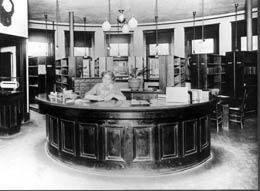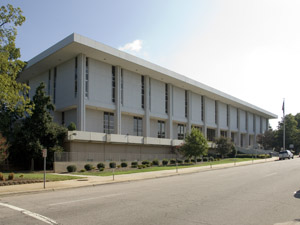
A library is a collection of materials, books or media that are easily accessible for use and not just for display purposes. It is responsible for housing updated information in order to meet the user's needs on a daily basis. A Library provides physical or digital access materials, and may be a physical location or a virtual space, or both. A library's collection can include printed materials and other physical resources in many formats such as DVDs, CDs and Cassette as well as access to information, music or other content held on bibliographic databases.

The reference desk or information desk of a library is a public service counter where professional librarians provide library users with direction to library materials, advice on library collections and services, and expertise on multiple kinds of information from multiple sources.

A library classification is a system of knowledge organization by which library resources are arranged and ordered systematically. Library classifications use a notational system that represents the order of topics in the classification and allows items to be stored in that order. Library classification systems group related materials together, typically arranged as a hierarchical tree structure. A different kind of classification system, called a faceted classification system, is also widely used, which allows the assignment of multiple classifications to an object, enabling the classifications to be ordered in many ways.
Interlibrary loan is a service whereby a patron of one library can borrow books, DVDs, music, etc. and/or receive photocopies of documents that are owned by another library. The user makes a request with their home library; which, acting as an intermediary, identifies libraries with the desired item, places the request, receives the item, makes it available to the user, as well as arranges for its return. The lending library usually sets a due date and overdue fees of the material borrowed. Although books and journal articles are the most frequently requested items, some libraries will lend audio recordings, video recordings, maps, sheet music, and microforms of all kinds. In some cases, nominal fees accompany the interlibrary loan services.

The National Library of Australia (NLA), formerly the Commonwealth National Library and Commonwealth Parliament Library, is the largest reference library in Australia, responsible under the terms of the National Library Act 1960 for "maintaining and developing a national collection of library material, including a comprehensive collection of library material relating to Australia and the Australian people", thus functioning as a national library. It is located in Parkes, Canberra, ACT.
Landsbókasafn Íslands – Háskólabókasafn is the national library of Iceland which also functions as the university library of the University of Iceland. The library was established on December 1, 1994 in Reykjavík, Iceland, with the merger of the former national library, Landsbókasafn Íslands, and the university library. It is by far the largest library in Iceland with about one million items in various collections. The library's largest collection is the national collection containing almost all written works published in Iceland and items related to Iceland published elsewhere. The library is the main legal deposit library in Iceland. The library also has a large manuscript collection with mostly early modern and modern manuscripts, and a collection of published Icelandic music and other audio. The library houses the largest academic collection in Iceland, most of which can be borrowed for off-site use by holders of library cards. University students get library cards for free, but anyone can acquire a card for a small fee. The library is open for public access.
Deweloping a library collection is the process of building the library materials to meet the information needs of the users in a timely and economical manner using information resources locally held, as well as from other organizations. In other words Library Collection can also be termed as collection management, resource and information management. Collection development refers to the process of systematically building Library collection of a given or particular Library in order to respond effectively to the active users and regular users of a particular Library. However, the Collection development should be geared primarily to its users and must also be effective enough in order to be responsive to the total community needs it serves.
In library science, special collections are libraries or library units that house materials requiring specialized security and user services.
The University of California operates the largest academic library system in the world. It manages more than 40.8 million print volumes in 100 libraries on ten campuses. The purpose of these libraries is to assist research and instruction on the University of California campuses. While each campus library is separate, they share facilities for storage, computerized indexing, digital libraries and management. For example, each campus maintains its own computerized library catalog and simultaneously participates in the systemwide union catalog, MELVYL.
The California Digital Library (CDL) was founded by the University of California in 1997. Under the leadership of then UC President Richard C. Atkinson, the CDL’s original mission was to forge a better system for scholarly information management and improved support for teaching and research. In collaboration with the ten University of California Libraries and other partners, CDL assembled one of the world's largest digital research libraries. CDL facilitates the licensing of online materials and develops shared services used throughout the UC system. Building on the foundations of the Melvyl Catalog, CDL has developed one of the largest online library catalogs in the country and works in partnership with the UC campuses to bring the treasures of California's libraries, museums, and cultural heritage organizations to the world. CDL continues to explore how services such as digital curation, scholarly publishing, archiving and preservation support research throughout the information lifecycle.
Library technical services are the ongoing maintenance activities of a library's collection, including the three broad areas of collection development, cataloging, and processing. Technical services are the infrastructure that enable the user's experience of many library services.

The State Library of North Carolina is an institution which serves North Carolina libraries, state government employees, genealogists, and the citizens of North Carolina. The library is the main depository for North Carolina state publications and serves the needs of North Carolina government agencies and state government employees by providing access to information resources that are vital to public decision-making and economic development.

In library and archival science, preservation is a set of activities aimed at prolonging the life of a record, book, or object while making as few changes as possible. Preservation activities vary widely and may include monitoring the condition of items, maintaining the temperature and humidity in collection storage areas, writing a plan in case of emergencies, digitizing items, writing relevant metadata, and increasing accessibility. Preservation, in this definition, is practiced in a library or an archive by a librarian, archivist, or other professional when they perceive a record is in need of care.

National and University Library in Zagreb (NSK) is the national library of Croatia and central library of the University of Zagreb.
Preservation survey is the process of collecting and analyzing data about the physical condition of library materials.
An inventory is an itemized list of cultural property items that the museum has accessioned or received via loan(s) and must be physically located by an examiner. A complete, one-hundred percent inventory, or a random inventory of the collection must be carried out periodically to ensure the museum is operating under best practices and for security purposes. The museum is legally responsible and ethically obligated for the maintenance of up-to-date information detailing the location of all objects within the collection, including loaned items and objects that have yet to be accessioned; this is stipulated by many museum associations, including the American Association of Museums.

The Library of Congress (LC) is the research library that officially serves the United States Congress and is the de facto national library of the United States. It is the oldest federal cultural institution in the United States. The library is housed in three buildings on Capitol Hill in Washington, D.C.; it also maintains a conservation center in Culpeper, Virginia. The library's functions are overseen by the Librarian of Congress, and its buildings are maintained by the Architect of the Capitol. The Library of Congress is one of the largest libraries in the world. Its "collections are universal, not limited by subject, format, or national boundary, and include research materials from all parts of the world and in more than 450 languages."

The Younes and Soraya Nazarian Library is a central academic library of the University of Haifa, and one of the largest in Israel. It is also one of the most progressive Israeli libraries in terms of service, collection, physical space, and library information systems.

The conservation and restoration of books, manuscripts, documents and ephemera is an activity dedicated to the preservation and protection of items of historical and personal value made primarily from paper, parchment, and leather. When applied to cultural heritage, conservation activities are generally undertaken by a conservator. The primary goal of conservation is to preserve the lifespan of the object as well as maintaining its integrity by keeping all additions reversible. Conservation of books and paper involves techniques of bookbinding, restoration, paper chemistry, and other material technologies including preservation and archival techniques.
A collective collection, also known as a shared printprogram, involves mostly academic or research libraries collaborating to retain, develop, and provide access to their physical collections. Most collective collections comprise monographs and/or serials. Other efforts have addressed acquisition and/or retention of microform, federal government documents, and digital collections.









